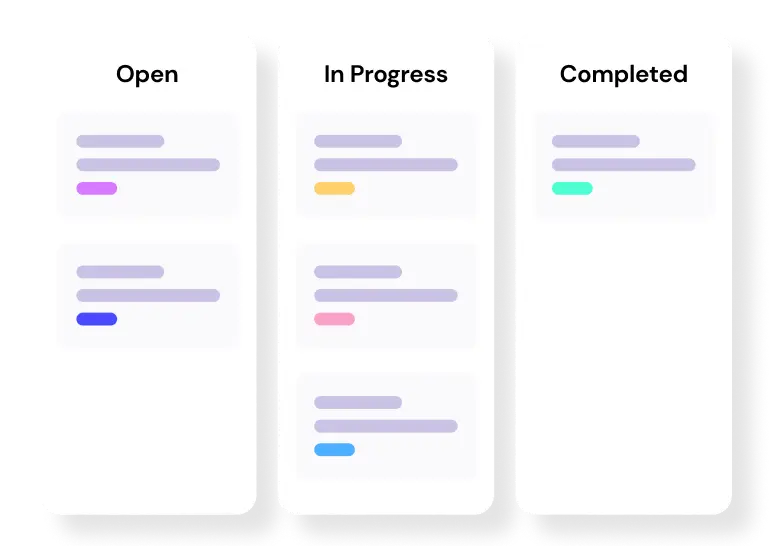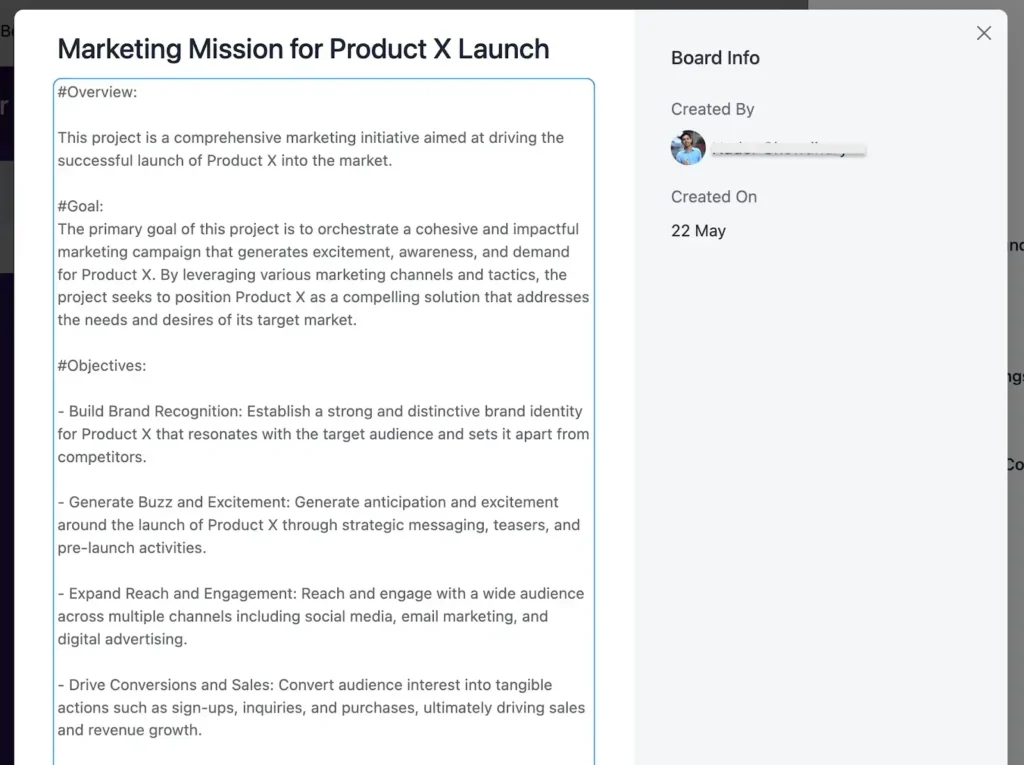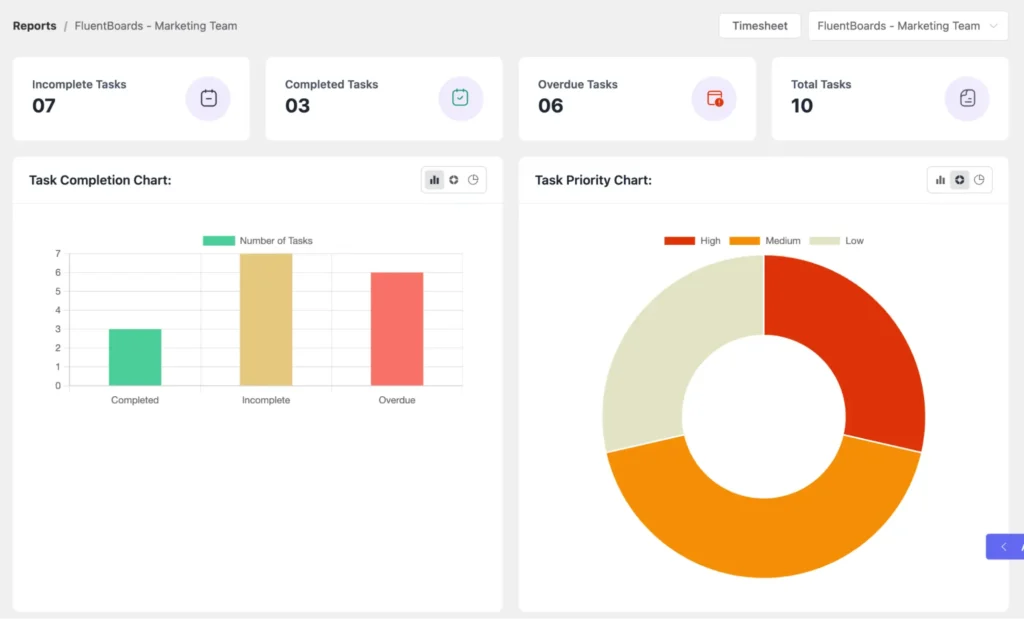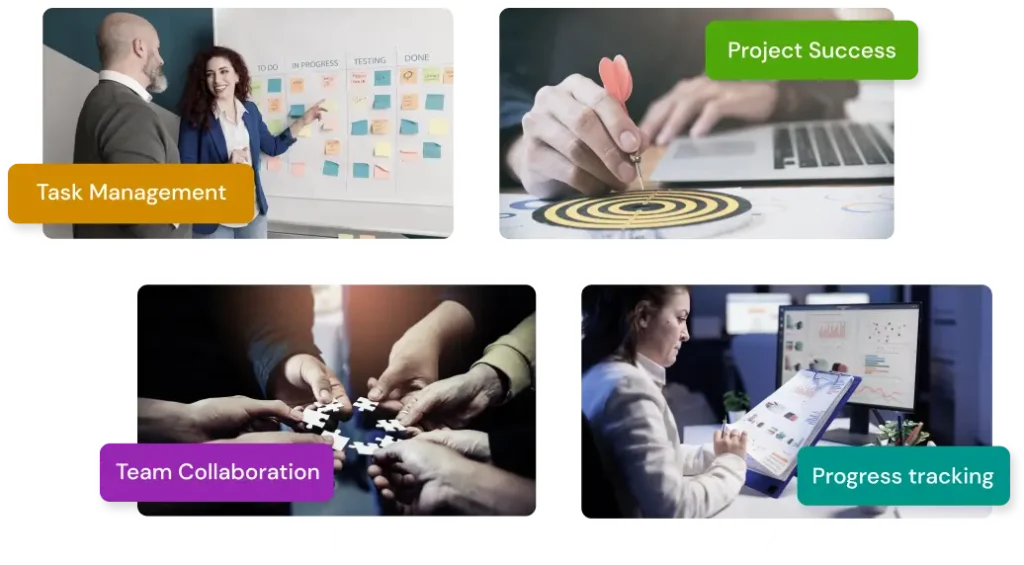
Project Objectives Explained: What Are they, Why They Matter and How to Write Them
You’ve got a big project ahead. The purpose is clear, the goal is defined, and your team is ready to start.
Here’s what usually happens next:
- You dive straight into tasks
- Start assigning work
- Schedule meetings and timelines
At first, it feels productive. But soon, progress slows, and team members have different ideas of what “success” looks like.
Sound familiar?
This confusion happens when there’s a gap between your broad goal and actionable steps. And that’s where project objectives come in.
In this blog, you’ll learn what project objectives are, why they matter, and how to write them clearly and effectively to keep your team aligned from start to finish.
Let’s dive in.
What Are Project Objectives?
Project objectives are specific, measurable outcomes that define what your project will accomplish within a set timeframe.
They transform broad project goals into clear, actionable targets that guide every project decision and activity throughout the project management lifecycle.
Well-crafted objectives serve three critical functions:
- They provide direction for team members
- Establish success criteria for stakeholders and
- Create accountability by setting important project KPIs
Simply put, project objectives clarify the “how” of success, aligning each task with the broader business strategy and goals while staying within practical constraints.
Project Objectives vs. Other Project Management Terms
Let’s break down how project objectives differ from other project management terms and what each one really means –
| Project Objectives vs. Project Goals | Project goals define the big picture and overall success, while project objectives break down the specific steps needed to achieve that success |
| Project Objectives vs. Project Scope | Project scope defines the boundaries of what will and won’t be done, while project objectives outline the specific results to be achieved within those boundaries |
| Project Objectives vs. Project Milestones | Project milestones are checkpoints that track your progress toward objectives by marking the completion of key tasks or phases |
| Project Objectives vs. Project Deliverables | While project objectives define the results you want to achieve, deliverables are the tangible outputs your team produces to help make those results happen |

Level up your WordPress project management game with this Trello equivalent solution – where limitless possibilities come at an unbeatable price!
What Are the Main Types of Project Objectives?
Project objectives can be categorized based on their focus and purpose. Understanding these key types helps ensure comprehensive project planning and execution-
- Financial objectives: Manage project costs to stay within budget, optimize expenses, and boost client revenue, like increasing web traffic with a compelling website.
- Quality objectives: Produce top-tier deliverables that meet client standards, ensuring reliability and value to foster trust and secure repeat business opportunities.
- Strategic objectives: Support overarching business aims, such as a landscaping firm creating stunning flower-lined paths to lead as the top aesthetic landscape provider.
- Time-Based objectives: Establish clear time frames for milestones to drive timely project completion, ensuring adherence to schedules and meeting critical delivery targets.
- Performance objectives: Target specific outcomes like enhanced efficiency, productivity, or customer satisfaction within set timeframes to elevate project success metrics.
- Business objectives: Monitor profitability, customer loyalty, and market expansion to ensure projects align with company goals while identifying strengths and growth potential.
- Regulatory compliance objectives: Uphold legal and industry standards through robust policies and procedures, ensuring the project remains compliant and ethically sound throughout.
The Importance of Clearly Defined Project Objectives
Establishing clear objectives from the very start isn’t just beneficial, it’s essential for a project’s success. According to PMI, a project faces a 37% chance of failure with poorly defined objectives and milestones.
Here’s how clear objectives make the difference:
Clear direction and focus
Objectives eliminate ambiguity and serve as a roadmap, keeping teams concentrated on specific goals rather than scattered activities.
Measurable progress
Well-defined objectives include KPIs that allow project managers to track progress and make informed adjustments throughout the project.
Stakeholder alignment
Clear objectives ensure everyone works toward common business goals, reducing conflicts and improving project team collaboration.
Better decision-making
Established objectives give project managers a framework for making strategic decisions that align with project priorities.
Increased accountability
Specific objectives create clear expectations, enabling team members to take ownership and deliver measurable results.
Motivation and engagement
Objectives connect individual work to larger organizational goals, helping employees understand their meaningful contribution.
How to Write Objectives of a Project
Apply these straightforward approaches when crafting objectives that drive real progress-
1. Understand the purpose and align with bigger goals
Before writing your objectives, start by understanding the main purpose of the project and how it supports broader organizational goals.

Your objectives should be crafted with these SMART goals in mind. When objectives align closely with your goals, they naturally shape the project’s scope, milestones, and deliverables to deliver real value.
2. Involve your team and stakeholders
Once you’ve clarified the project’s purpose and aligned with strategic goals, involve your project team and stakeholders in defining your objectives collaboratively.
Then gather their perspectives on what success looks like, potential project challenges, and key priorities that should guide the project.
This builds buy-in and ensures they reflect realistic expectations and practical insights.
Also, the shared understanding helps your team approach planning, execution, and decision-making with clarity, making it easier to:
- Define milestones
- Break down objectives into smaller tasks
- Set clear deliverables and deadlines
- Assign roles and responsibilities
3. Use SMART framework
Now, it’s important to have a structured approach to shape those collaborative insights into objectives that guide your entire project lifecycle.
The SMART framework helps project managers create structure by ensuring every objective meets five essential criteria:
- Specific: Define exactly what you want to accomplish. Your objective should clearly cover the specific result your team is working toward.
- Measurable: Include concrete criteria to track progress and determine success. Use percentage changes, specific numbers, or quantifiable assets so you can definitively assess achievement at project completion.
- Achievable: Ensure your objectives are realistic within your project scope, timeline, and available resources. Unrealistic objectives lead to scope creep, delays, and team overwork.
- Relevant: Align each objective with your overall project goals and company mission. Every objective should directly support the broader purpose and strategic value.
- Time-bound: Set clear deadlines within a realistic time frame to align with your overall project schedule. This creates urgency and helps prioritize efforts.
Note: The SMART framework applies to both project goals and objectives. Goals use these criteria for high-level strategy, while objectives apply them to specific execution steps.
4. Write clear, concise, and prioritized Objectives
With your team’s input and the SMART framework, write objectives that are both clear and actionable, ensuring your team understands exactly what needs to be accomplished and how.
Not every objective deserves equal attention. Therefore, prioritize those with the biggest impact on your project’s success based on stakeholder insights to keep your team focused on what truly matters.
Also, keep each objective as a clear, quick reference point that helps with daily decisions so your team can focus their efforts effectively without getting overwhelmed by competing priorities.
5. Track progress and adjust objectives as needed
Effective objectives require ongoing attention throughout your project. Monitor progress regularly during each project phase and keep your team informed about task completion status and bottlenecks.
Include objective updates and task progress in your project status reports, sharing whether you’re on track, at risk, or off track. This keeps everyone aligned and allows for recalibration when needed.

Pay attention to overdue and incomplete tasks, as these indicators help identify where objectives may need refinement or additional resources.
If the scope or conditions change, update objectives to stay relevant and achievable. This flexibility and clear communication help manage unexpected challenges while keeping the team engaged.

Step into the Future of Project Management!
Real-Life Examples of Effective Project Objectives
Effective project objectives provide teams with a clear direction and accountability. When aligned with the SMART framework, they transform broad goals into focused, actionable steps.
Let’s explore practical examples that show how SMART objective statements guide projects toward success:
Financial objective
Objective: Reduce operational project costs by 10% by the end of the fiscal year through optimized resource allocation and vendor negotiations while maintaining budget constraints.
SMART Breakdown:
Specific: Focuses on reducing project costs through specific actions (resource allocation and vendor negotiations).
Measurable: A 10% cost reduction can be tracked using financial reports.
Achievable: Optimization and negotiations are within the project team’s control.
Relevant: Aligns with the organization’s goal of improving financial efficiency.
Time-bound: Set to be achieved by the end of the fiscal year.
Customer satisfaction objective
Objective: Increase customer satisfaction scores by 15% on a 100-point scale within six months by implementing a new online ticketing system and training support staff.
SMART Breakdown:
Specific: Targets customer satisfaction improvement via a ticketing system and staff training.
Measurable: Measured by a 15% increase on a 100-point scale.
Achievable: Feasible with the introduction of a new system and training.
Relevant: Supports the goal of enhancing customer experience.
Time-bound: To be achieved within six months.
Marketing objective
Objective: Generate 200 qualified leads per month for the new product launch by the end of Q2 through targeted SEO campaigns and social media advertising.
SMART Breakdown:
Specific: Focuses on lead generation via SEO and social media.
Measurable: Quantified as 200 qualified leads per month.
Achievable: Realistic with a focused marketing strategy.
Relevant: Aligns with the goal of increasing product sales.
Time-bound: Set for completion by the end of Q2.
Product development objective
Objective: Develop and launch a new mobile app feature that reduces user task completion time by 30% by the end of Q3, validated through user testing.
SMART Breakdown:
Specific: Targets a new feature to reduce task completion time.
Measurable: A 30% reduction can be measured via user testing metrics.
Achievable: Feasible within the development team’s capabilities.
Relevant: Enhances user experience, aligning with product improvement goals.
Time-bound: Set to be achieved by the end of Q3.
Operational efficiency objective
Objective: Improve internal project management workflows to reduce task turnaround time by 20% within four months by implementing a new tool.
SMART Breakdown:
Specific: Focuses on streamlining workflows with a new tool.
Measurable: A 20% reduction in turnaround time can be tracked.
Achievable: Realistic with the adoption of a suitable tool.
Relevant: Supports the goal of improving team productivity.
Time-bound: Set to be achieved within four months.
Common Mistakes to Avoid in Setting Project Objectives
Even with the best intentions, defining project objectives comes with real hurdles that can derail your planning process.
Here are the key challenges that trip up most projects:
- Lack of stakeholder involvement creates incomplete objectives that miss critical perspectives and requirements
- Unclear expectations from leadership and team members lead to misaligned objectives and confused priorities
- Unrealistic target setting breeds frustration, kills motivation, and sets your entire project up for failure
- Poor communication during objective planning results in objectives that don’t reflect actual project needs
- Scope creep during objective setting creates bloated, unfocused objectives that try to accomplish too much
- Conflicting priorities between departments result in objectives that work against each other
- Time pressure during the planning phase forces rushed objective setting without proper consideration
It’s Time to Get Clear, Get Focused, Get Results!
That’s a wrap on project objectives! You now have the core insights to guide your team toward meaningful outcomes and measurable success.
From understanding your project’s purpose to applying the SMART framework and tracking progress, this complete roadmap will help you create objectives that drive real results.
Remember, objectives aren’t just tasks, they define direction, focus effort, and transform your project goals into achievable results.
Thanks for reading! And here’s to your next winning project!
Let’s redefine project management with FluentBoards!
Get Tips, Tricks, & Updates
We won’t send you spam.









![how to create a project management workflow [x steps] (2)](https://fluentboards.com/wp-content/uploads/2025/11/How-to-create-a-project-management-workflow-x-steps-2-768x402.webp)





Leave a Reply